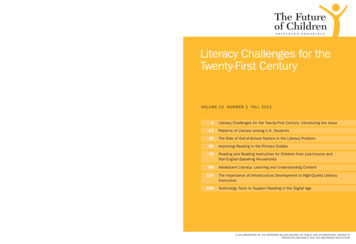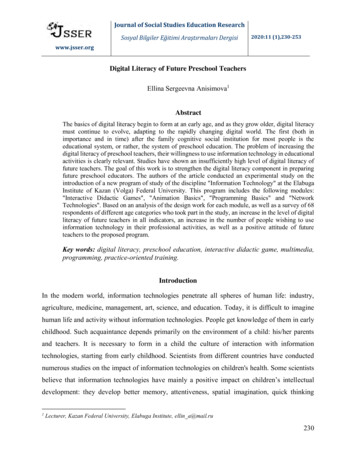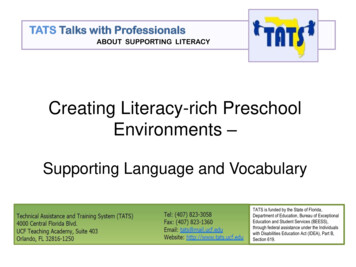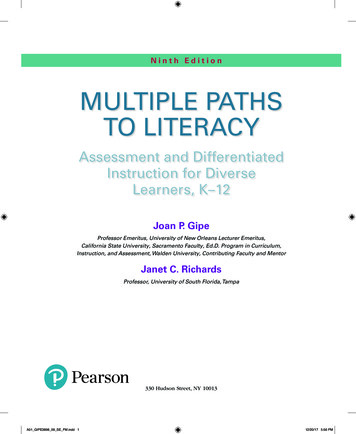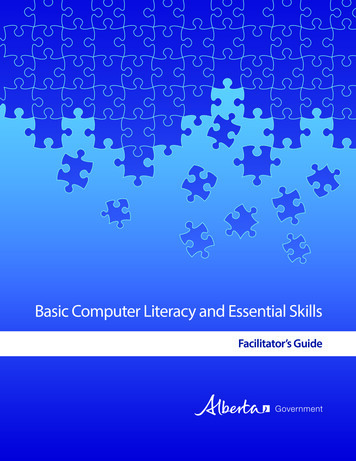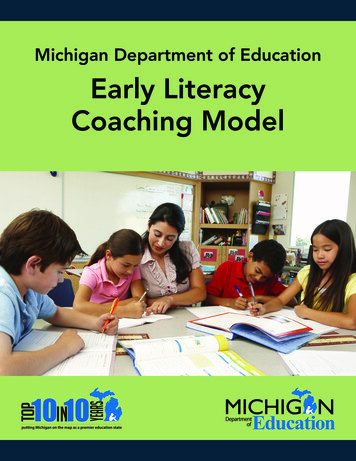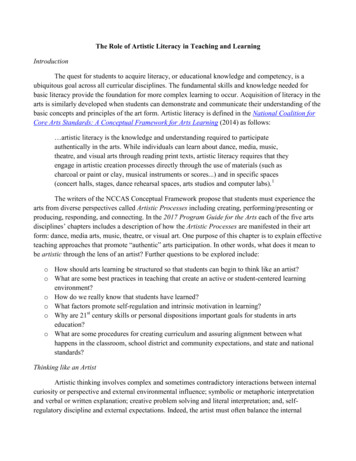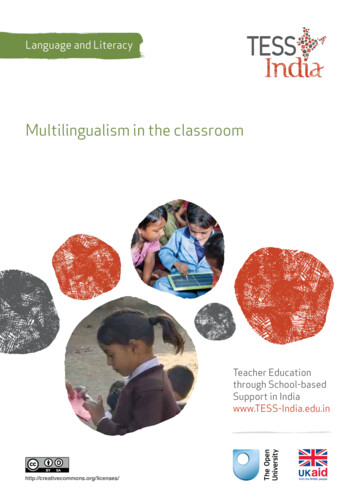
Transcription
Language and LiteracyMultilingualism in the classroomTeacher Educationthrough School-basedSupport in rg/licenses/
TESS-India (Teacher Education through School-based Support) aims to improve the classroom practices ofelementary and secondary teachers in India through the provision of Open Educational Resources (OERs) tosupport teachers in developing student-centred, participatory approaches. The TESS-India OERs provideteachers with a companion to the school textbook. They offer activities for teachers to try out in theirclassrooms with their students, together with case studies showing how other teachers have taught thetopic and linked resources to support teachers in developing their lesson plans and subject knowledge.TESS-India OERs have been collaboratively written by Indian and international authors to address Indiancurriculum and contexts and are available for online and print use (http://www.tess-india.edu.in/). The OERsare available in several versions, appropriate for each participating Indian state and users are invited toadapt and localise the OERs further to meet local needs and contexts.TESS-India is led by The Open University UK and funded by UK aid from the UK government.Video resourcesSome of the activities in this unit are accompanied by the following icon:. This indicates that youwill find it helpful to view the TESS-India video resources for the specified pedagogic theme.The TESS-India video resources illustrate key pedagogic techniques in a range of classroom contexts inIndia. We hope they will inspire you to experiment with similar practices. They are intended to complementand enhance your experience of working through the text-based units, but are not integral to them shouldyou be unable to access them.TESS-India video resources may be viewed online or downloaded from the TESS-India website,http://www.tess-india.edu.in/). Alternatively, you may have access to these videos on a CD or memory card.Version 2.0 LL12v1All India - EnglishExcept for third party materials and otherwise stated, this content is made available under a CreativeCommons Attribution-ShareAlike licence: http://creativecommons.org/licenses/by-sa/3.0/
Multilingualism in the classroomWhat this unit is aboutThis unit is about the reality in many classrooms of teaching students whose home language is not thelanguage of the school. Such situations are often viewed as challenging. This unit aims to raise awarenessand understanding of the positive contribution that multilingualism can make to the learning and inclusionof all students in the language classroom.What you can learn in this unitHow to draw on your students’ multilingualism as a resource for learning.How to plan opportunities for students to learn in all their languages in your classroom teaching .The benefits of ‘translanguaging’ in the classroom. Why this approach is importantIn much of the world, including India, multilingual students are the norm rather than the exception. There ismuch research and evidence about the cognitive and practical benefits of knowing more than one language.Such knowledge is a tremendous resource for teaching and learning. Whatever their subject specialism,every teacher should seek out opportunities to celebrate, promote and exploit the linguistic knowledge andskills of all their students. As a language and literacy teacher, you have a particular responsibility to do this.This unit shows you how.1 Introducing the multilingual classroomActivity 1: Key principlesThe three statements that follow are based on the findings of international educational research oneffective classroom practice in multilingual contexts: Students learn best in the language they know best.Teachers teach most effectively in the language they’re most familiar with.The longer teaching and learning take place in the first language, the better the educationaloutcomes.Now answer the questions below, discussing them with a colleague if possible: As a teacher, what are the challenges of integrating these statements into your daily classroompractice?Is there a ‘language gap’ between you and your students, or amongst the students that make upyour class? If so:o How does this affect your teaching and their learning?o How does this affect relationships in the classroom?Do you do anything to acknowledge your students’ other languages in your teaching? Why or whynot?The three statements above reflect increasing powerful evidence of the positive impact that prolongedteaching in the mother tongue has on students’ school attendance and their long-term educational success.www.TESS-India.edu.in1
Multilingualism in the classroomWhile the introduction of wholly mother tongue-based teaching may not be possible in your school, thereare many small changes you can make to your teaching practice to draw on the valuable home languageresources that your students bring to the classroom.Case Study 1: Observing studentsMr Dharmendra, a Class I and II teacher in a rural school in Madhya Pradesh, describes what he noticedwhen he observed his students communicating in their home languages.I used to have quite negative attitudes towards my students using their home language in school. I felt thatthe best way for them to learn the school language was to listen to and use it all the time. I believed thatmixing languages in school could be confusing to them. Perhaps the fact that I could understand and speakonly very little of their home languages was another reason why I was uncomfortable about them usingthem in class.Some of my Class I and II students were very quiet in my lessons. It was difficult for me to know what theyunderstood and what they were learning.One morning, I noticed that two normally reticent students that I had paired up were talking animatedlyabout a Hindi reading text in Neemadi, the language they spoke at home. That lunchtime, I overheard a veryshy student explaining a recently introduced science-related concept to his friend in the playground, withthe help of a diagram, in their home language, Bhili. At the end of the day, I observed a child who did notusually talk, retelling a story I had told the class earlier in Hindi to her grandfather in their home language,Malvi.I was struck by the confidence, capability, good humour and social skills of these children, as theycommunicated with others in the language they knew best. I realised that I needed to provideopportunities for them to display these same qualities in the classroom too.Pause for thoughtTake time each day to observe and listen to those students who may otherwise be quiet inclass when they are talking to others in a more familiar shared language. What qualities andbehaviours do they demonstrate that perhaps you had not been aware of before?Now read Resource 1 on involving all your students in your classroom activities.Video: Involving India.edu.in
Multilingualism in the classroom2 Valuing multilingualism in the classroomActivity 2: A class language surveyUndertake a language survey with your class. Start by talking to your students about the languages youknow – perhaps clarifying whether you can understand a few words, speak the language fluently or write it– and explaining how you gained that knowledge, be this from your parents or grandparents, from livingsomewhere, or from studying it in school, for example.Using chart paper, make a large table. Write with your name, followed by your students’ names, down theleft-hand side, and a list of languages across the top. Invite your students to state which languages theyknow and add ticks to the chart accordingly. When you have finished, put the survey chart up on theclassroom wall.If any students are absent on the day you do the survey, be sure to update the chart on their return. Insertextra rows at the bottom in case any new students join the class during the year. You may wish to surveythe head teacher and other members of staff and add this information, too.Depending on the age of your students, you could make the survey more detailed by noting whether theycan understand, speak, read or write the languages have mentioned.Pause for thought Were your students pleased to share their language knowledge?Did you encounter any difficulties in trying to find out which languages your studentsknow? If so, what were they?What could you do as a follow-up activity with your students?Discriminatory perceptions of low-status castes may mean that some students are reluctant to ‘admit’ toknowing some of the languages associated with these communities. In this activity it is therefore importantto positively emphasise the value that knowledge of different languages and cultures brings to people’slives in general and the classroom in particular. Talk about your own knowledge of minority languages, evenif it is limited, or your wish to learn them.The fact that the distinction between languages and dialects is often fluid, or the possibility that studentsmay not know the names of the languages they speak, are other reasons why it is not alwaysstraightforward to obtain precise information about such knowledge. Your chart should therefore beviewed a starting point, with students helping to amend the information over time.Case Study 2: Using local language wordsIn the following case study from Jharkhand, a teacher describes how some of their students were confusedby the words used to illustrate letters on the alphabet chart on the wall.Most of my students are Ho speakers and know very few Hindi words when they first come to school. Inoticed that some students were telling me the wrong words represented by the pictures on the Hindialphabet chart on the classroom wall. They said ‘nayal’ (the Ho word for ‘plough’) instead of ‘hal’ (the Hindiword for ‘plough’). When I asked them what letter was represented, the students told me that it was ‘n’, thefirst letter for ‘plough’ in the Ho language, rather than ‘h’, the first letter of ‘plough’ in Hindi.www.TESS-India.edu.in3
Multilingualism in the classroomFigure 1 A plough. Which letter of the alphabet doesit represent in your students’ home language?I knew that I needed to help my students to learn the names and sounds of the Hindi letters correctly, so Imade an alphabet chart using words from the Ho language. In this is way, they could learn the letter–soundcorrespondences of the Hindi alphabet more easily. I then helped them to learn the Hindi illustrative wordsas well. This helped them build up their Hindi vocabulary too.Having read the case study, now try the following two activities, which focus on multilingualism in yourclassroom.Activity 3: Making an alphabet chartMight any of your younger students get confused by the words represented by the pictures illustrating theHindi alphabet chart?Find suitable words in their home language and use them to make an alphabet chart or book that helps yourstudents to learn the Hindi letters. If you are not sufficiently familiar with their home language, askcolleagues, members of the community or the students themselves to suggest suitable words. Involveyour students in cutting out and pasting the pictures into the chart or book as well.Activity 4: Incorporating multilingual practice in your classroomHow can you acknowledge and value the different languages that your students bring to the classroom?Start a list of ideas. Talk to your colleagues or visit their classrooms for inspiration. Choose one toimplement in your classroom over the next month. Some suggestions are listed below.GreetingsAsk your multilingual students to teach their classmates a greeting in their home language. Develop aroutine whereby, at the start of the day, you greet your students in the school language, and then in each oftheir home languages, with the whole class responding to the series of greetings accordingly. Do the sameto say goodbye at the end of the school day.LabelsLabel the features of your classroom (such as the window, door, blackboard, cupboard) in both Hindi andyour students’ home language. Use different-coloured pens or card to help distinguish the differentlanguages. If your multilingual students are literate in their home language, they can help to write thetranslated labels themselves.4www.TESS-India.edu.in
Multilingualism in the classroomA multilingual word wallCreate an evolving word wall in your classroom, by posting up useful words and expressions in yourstudents’ home languages (for example, ‘hello’, ‘goodbye’, ‘sorry’, ‘thank you’). Seek out opportunities toinvite your students to contribute new words. Use different-coloured pens or card to distinguish thelanguages, as with the labels above.Multilingual reading materialStart a collection of books, magazines, leaflets and other reading materials in the languages that yourstudents speak and add these items to your reading corner (Figure 2).Figure 2 A variety of reading materials in the reading corner.Multilingual dictionariesInvolve your students in creating bilingual or multilingual dictionaries. Depending on your students’ needs,these dictionaries could focus on simple words and pictures, vocabulary relating to everyday topics (suchas school, home, the park, body parts, animals) or subject-specific terms (pertaining to maths, science andenvironmental science, for example).If your students are studying English, they could compile a multilingual dictionary that lists words inEnglish, Hindi and their home language. Leave the dictionaries in an accessible place for all you students tolook at. Keep a list of new words and set aside a time for your students to add these and others to thedictionary on a regular basis.3 Translanguaging in the classroom‘Translanguaging’ is a relatively new term for an age-old practice – that of switching between the languagesone knows in order to maximise communicative potential. Translanguaging is flexible multilingualism.Whether it involves combining elements from different languages in the same utterance (‘codeswitching’) oralternating between languages in different parts of a task, it is a natural means of employing one’s linguisticresources to their greatest effect. It occurs because individuals associate a given language with a specificwww.TESS-India.edu.in5
Multilingualism in the classroomtask, topic or situation, or because some concepts (such as ‘the Internet’) tend to be more commonlyexpressed in a given language, or because it can be playful and witty. Translanguaging is something mostpeople do all the time with their friends, family and other members of the community without even thinkingabout it.In the classroom, translanguaging may involve: translating between languagescomparing and being playful with different languagesmixing words and expressions from different languages in the same spoken or written utteranceusing the home language in one part of an activity and the school language in another part.Thus, students might listen to information in one language and explain the gist of it orally or make writtennotes about it in another. Similarly, they might read a text in one language and talk about it or summarise itin writing in another.As a resource for both teachers and students, translanguaging has many educational benefits because it: validates multilingualism, viewing it as a valuable asset rather than a problem or a temporarytransitional interactional tool in early schoolingrepresents a more efficient and effective teaching and learning technique than is possible in onelanguage onlyoffers opportunities for individuals to develop rich and varied communicative repertoires for usewithin and outside school.Case Study 3 Translanguaging in the classroomMrs Indra, a Class IV teacher in a rural school outside Bhopal, describes how she has started to incorporatetranslanguaging in her language lessons.Many of my students are not first-language Hindi speakers. Since I started incorporating translanguagingpractices into their language lessons three months ago, they have become much more talkative andengaged in their learning. Their confidence in using Hindi has noticeably improved too. I have observed thatmonolingual Hindi speakers in my class are starting to pick up words and phrases from their classmates aswell.If my students are going to read a section or page of their Hindi textbook, I begin by introducing the topic,inviting my students to volunteer anything they know about it and encouraging them to translate the keyHindi vocabulary into their home language. I ask them to help me if I can’t follow what they are saying.I then ask my students to read a section or page of their Hindi textbook aloud in pairs or small groups, orsilently and independently on their own. In either case, I invite them to pause at the end of each page orsection and discuss what they have just read with their partner or other group members, making sense of itand establishing the meaning of any unfamiliar words together. I suggest to them that they use their homelanguage for this. I encourage them to add any new words or expressions in the dictionaries they havecreated.If I want pairs or groups of students to present something to the rest of the class in the school language, Iencourage them to use their language to discuss how they will express their ideas first. I do the same if Iwant them to write a summary or report in the school language.To maintain the interest of all my students, I try to vary the organisation of the pairs and groups, whileensuring that they include at least two students of the same home language each time. Sometimes I place6www.TESS-India.edu.in
Multilingualism in the classroomstudents with similar competence in the school language together. At other times, I place a more confidentstudent with a less confident one, so that the former can support the latter in their shared home language.If there is someone in the group who does not speak the shared home language, I ensure that my studentstranslate what they are discussing into the school language.Recently I located a traditional short story that was available in Hindi and my students’ home language. Iused this with my Class VII students. I made copies of the stories in each language and got small groups ofstudents to read them in parallel. I then invited them to use their home language to compare the differentversions of the two stories, including the key words that had been used in each.Figure 3 Students discuss a topic in pairs using their home language.Pause for thought Notice which parts of the activities Mrs Indra encouraged her students to do in theirhome language and which in the school language. Are there any patterns here?What instructions might Mrs Indra have used to support the translanguagingpractices described in the case study? Make a list of all those you can think of.Here are some possibilities: ‘In Hindi we say xxx, in [your home language], we say yyy.’‘How do you say xxx in [your home language]?’‘What [home language] words do you know for this topic?’‘Work in pairs. One pupil says the word in Hindi, the other in [their home language]. Then change over.’‘I’m going to ask the questions in Hindi. You can tell me the answer in [your home language].’‘You can start in [your home language], then move to Hindi.’‘You can use [your home language] to discuss this topic in your pairs [or groups], and then give yourreport back to the class in Hindi.’‘Now we have some time for questions in [your home language].’‘Make a list of new words in your notebook. Write the Hindi word on the left and the [home language}equivalent on the right.’(Adapted from Simpson, 2014)www.TESS-India.edu.in7
Multilingualism in the classroomActivity 5: Incorporating translanguaging in your classroomIdentify a forthcoming language lesson in which you can introduce translanguaging into your classroompractice. Note down the parts of each activity in which use of the school language or the students’ homelanguage would be most appropriate. Consider how to pair or group your students. Plan the lesson,revisiting and practising the instructional phrases that you are likely to use for each step (see above).Share your plan with a colleague if possible.When you are ready, implement the lesson. Begin by explaining to your students what the benefits oftranslanguaging are to learning and why you wish to encourage them to do this. Give them clearinstructions for each stage of the activity. Respond supportively to their use of their home language.You may find it helpful to read the key resource ‘Planning lessons’ (http://tinyurl.com/kr-planninglessons).Video: Planning se for thought How did your students respond to their first experiences of translanguaging in theclassroom?How was the experience different for you?Once you introduce translanguaging into your teaching practice, it is important to incorporate itconsistently in your lessons so that your students gain confidence in the acceptability of using their homelanguage in their learning on a regular basis.4 SummaryThis unit has discussed ways of exploiting the multilingualism that you and your students bring to school toenhance teaching, learning and inclusion. It has encouraged you to undertake a class language survey,create a multilingual classroom environment, and incorporate translanguaging activities into your languagelessons. Sustained practice of this type can have a lasting positive impact on your students’ social,cognitive and communicative development.ResourcesResource 1: Involving allWhat does it mean to ‘involve all’?The diversity in culture and in society is reflected in the classroom. Students have different languages,interests and abilities. Students come from different social and economic backgrounds. We cannot ignorethese differences; indeed, we should celebrate them, as they can become a vehicle for learning more abouteach other and the world beyond our own experience. All students have the right to an education and theopportunity to learn regardless of their status, ability and background, and this is recognised in Indian law8www.TESS-India.edu.in
Multilingualism in the classroomand the international rights of the child. In his first speech to the nation in 2014, Prime Minister Modiemphasised the importance of valuing all citizens in India regardless of their caste, gender or income.Schools and teachers have a very important role in this respect.We all have prejudices and views about others that we may not have recognised or addressed. As a teacher,you carry the power to influence every student’s experience of education in a positive or negative way.Whether knowingly or not, your underlying prejudices and views will affect how equally your students learn.You can take steps to guard against unequal treatment of your students.Three key principles to ensure you involve all in learning Noticing: Effective teachers are observant, perceptive and sensitive; they notice changes in theirstudents. If you are observant, you will notice when a student does something well, when they needhelp and how they relate to others. You may also perceive changes in your students, which mightreflect changes in their home circumstances or other issues. Involving all requires that you noticeyour students on a daily basis, paying particular attention to students who may feel marginalised orunable to participate.Focus on self-esteem: Good citizens are ones who are comfortable with who they are. They haveself-esteem, know their own strengths and weaknesses, and have the ability to form positiverelationships with other people, regardless of background. They respect themselves and theyrespect others. As a teacher, you can have a significant impact on a young person’s self-esteem; beaware of that power and use it to build the self-esteem of every student.Flexibility: If something is not working in your classroom for specific students, groups or individuals,be prepared to change your plans or stop an activity. Being flexible will enable you makeadjustments so that you involve all students more effectively.Approaches you can use all the time Modelling good behaviour: Be an example to your students by treating them all well, regardless ofethnic group, religion or gender. Treat all students with respect and make it clear through yourteaching that you value all students equally. Talk to them all respectfully, take account of theiropinions when appropriate and encourage them to take responsibility for the classroom by taking ontasks that will benefit everyone.High expectations: Ability is not fixed; all students can learn and progress if supportedappropriately. If a student is finding it difficult to understand the work you are doing in class, thendo not assume that they cannot ever understand. Your role as the teacher is to work out how best tohelp each student learn. If you have high expectations of everyone in your class, your students aremore likely to assume that they will learn if they persevere. High expectations should also apply tobehaviour. Make sure the expectations are clear and that students treat each other with respect.Build variety into your teaching: Students learn in different ways. Some students like to write;others prefer to draw mind maps or pictures to represent their ideas. Some students are goodlisteners; some learn best when they get the opportunity to talk about their ideas. You cannot suitall the students all the time, but you can build variety into your teaching and offer students a choiceabout some of the learning activities that they undertake.Relate the learning to everyday life: For some students, what you are asking them to learn appearsto be irrelevant to their everyday lives. You can address this by making sure that whenever possible,you relate the learning to a context that is relevant to them and that you draw on examples fromtheir own experience.www.TESS-India.edu.in9
Multilingualism in the classroom Use of language: Think carefully about the language you use. Use positive language and praise, anddo not ridicule students. Always comment on their behaviour and not on them. ‘You are annoying metoday’ is very personal and can be better expressed as ‘I am finding your behaviour annoying today.Is there any reason you are finding it difficult to concentrate?’, which is much more helpful.Challenge stereotypes: Find and use resources that show girls in non-stereotypical roles or invitefemale role models to visit the school, such as scientists. Try to be aware of your own genderstereotyping; you may know that girls play sports and that boys are caring, but often we express thisdifferently, mainly because that is the way we are used to talking in society.Create a safe, welcoming learning environment: All students need to feel safe and welcome atschool. You are in a position to make your students feel welcome by encouraging mutuallyrespectful and friendly behaviour from everyone. Think about how the school and classroom mightappear and feel like to different students. Think about where they should be asked to sit and makesure that any students with visual or hearing impairments, or physical disabilities, sit where they canaccess the lesson. Check that those who are shy or easily distracted are where you can easily includethem.Specific teaching approachesThere are several specific approaches that will help you to involve all students. These are described in moredetail in other key resources, but a brief introduction is given here: 10Questioning: If you invite students to put their hands up, the same people tend to answer. There areother ways to involve more students in thinking about the answers and responding to questions. Youcan direct questions to specific people. Tell the class you will decide who answers, then ask peopleat the back and sides of the room, rather than those sitting at the front. Give students ‘thinking time’and invite contributions from specific people. Use pair or groupwork to build confidence so that youcan involve everyone in whole-class discussions.Assessment: Develop a range of techniques for formative assessment that will help you to knoweach student well. You need to be creative to uncover hidden talents and shortfalls. Formativeassessment will give you accurate information rather than assumptions that can easily be drawnfrom generalised views about certain students and their abilities. You will then be in a good positionto respond to their individual needs.Groupwork and pair work: Think carefully about how to divide your class into groups or how to makeup pairs, taking account of the goal to include all and encourage students to value each other. Ensurethat all students have the opportunity to learn from each other and build their confidence in whatthey know. Some students will have the confidence to express their ideas and ask questions in asmall group, but not in front of the whole class.Differentiation: Setting different tasks for different groups will help students start from wherethey are and move forward. Setting open-ended tasks will give all students the opportunity tosucceed. Offering students a choice of task helps them to feel ownership of their work and to takeresponsibility for their own learning. Taking account of individual learning needs is difficult,especially in a large class, but by using a variety of tasks and activities it can be done.www.TESS-India.edu.in
Multilingualism in the classroomAdditional resources Multilingual education research: de to language readiness in multilingual contexts a Puliya Guidebook for a Childrens Language Readiness Programme in multilingual Jharkhand IndiaBilingual dictionaries in Jharkhand:o https://www.ac
I knew that I needed to help my students to learn the names and sounds of the Hindi letters correctly, so I made an alphabet chart using words from the Ho language. In this is way, they could learn the letter -sound correspondences of the Hindi alphabet more easily. I then helped them to learn the Hindi illustrative words as well.



